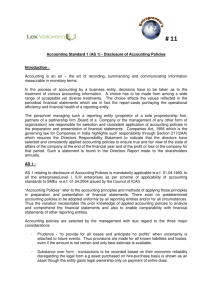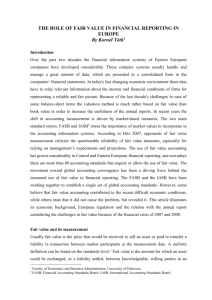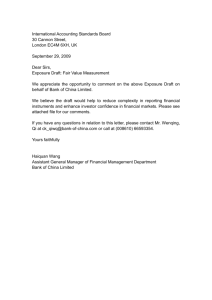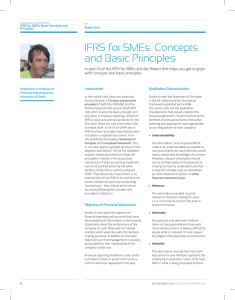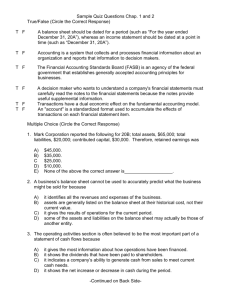international accounting standards board
advertisement
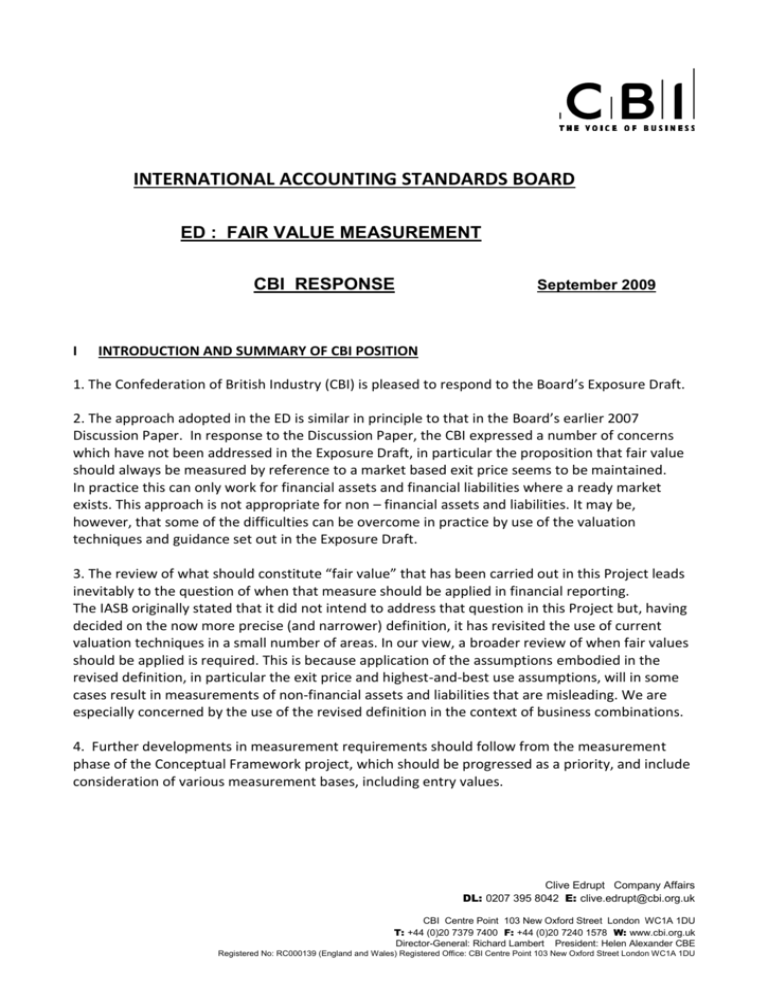
INTERNATIONAL ACCOUNTING STANDARDS BOARD ED : FAIR VALUE MEASUREMENT CBI RESPONSE I September 2009 INTRODUCTION AND SUMMARY OF CBI POSITION 1. The Confederation of British Industry (CBI) is pleased to respond to the Board’s Exposure Draft. 2. The approach adopted in the ED is similar in principle to that in the Board’s earlier 2007 Discussion Paper. In response to the Discussion Paper, the CBI expressed a number of concerns which have not been addressed in the Exposure Draft, in particular the proposition that fair value should always be measured by reference to a market based exit price seems to be maintained. In practice this can only work for financial assets and financial liabilities where a ready market exists. This approach is not appropriate for non – financial assets and liabilities. It may be, however, that some of the difficulties can be overcome in practice by use of the valuation techniques and guidance set out in the Exposure Draft. 3. The review of what should constitute “fair value” that has been carried out in this Project leads inevitably to the question of when that measure should be applied in financial reporting. The IASB originally stated that it did not intend to address that question in this Project but, having decided on the now more precise (and narrower) definition, it has revisited the use of current valuation techniques in a small number of areas. In our view, a broader review of when fair values should be applied is required. This is because application of the assumptions embodied in the revised definition, in particular the exit price and highest-and-best use assumptions, will in some cases result in measurements of non-financial assets and liabilities that are misleading. We are especially concerned by the use of the revised definition in the context of business combinations. 4. Further developments in measurement requirements should follow from the measurement phase of the Conceptual Framework project, which should be progressed as a priority, and include consideration of various measurement bases, including entry values. Clive Edrupt Company Affairs DL: 0207 395 8042 E: clive.edrupt@cbi.org.uk CBI Centre Point 103 New Oxford Street London WC1A 1DU T: +44 (0)20 7379 7400 F: +44 (0)20 7240 1578 W: www.cbi.org.uk Director-General: Richard Lambert President: Helen Alexander CBE Registered No: RC000139 (England and Wales) Registered Office: CBI Centre Point 103 New Oxford Street London WC1A 1DU Convergence with US GAAP 5. We welcome the Board’s willingness to consider improvements over the US GAAP equivalent, SFAS 157. It would be ideal if IFRS and US GAAP both moved as necessary to reach the same highquality solution and thus convergence was promoted. However, the priority should be that the IASB should aim to reach a high-quality solution for IFRS, even if it has not been possible to achieve consensus with the FASB. Exit and entry prices 6. We remain of the view that fair value should not always be measured as an exit price. Under current IFRS, fair value is in practice measured sometimes as an entry price, sometimes as an exit price, and sometimes as an exchange value. In different circumstances, each of these approaches is appropriate. 7. For example, under current IFRS, fair value is often used as a substitute for cost in circumstances in which no cost measurement is available (such as for separable assets and liabilities in a business combination) or where historical cost is not relevant. In such cases, where a substitute is being sought for an unavailable entry price, it seems logical that the substitute value should be calculated on an entry-price basis. 8. Fair value is also used in IFRS as an updatable measure of current value in circumstances where historical cost is considered to provide significantly less useful information (for example, for certain financial instruments). In such cases, an argument can be made for either exit prices, entry prices or alternative fair value bases (e.g. mid-market price), and in practice each is used in different circumstances – and we believe appropriately so. 9. We note that a key point in the ED’s argument against using entry prices is that ‘a current entry price and a current exit price will be equal when they relate to the same asset or liability on the same date in the same form in the same market’. (BC28). A footnote adds that, where there is a difference between the two prices, it should be attributed to transaction costs. We agree with these statements where markets are perfectly competitive (which is usually not the case). However, given the ED’s analysis, it is not clear why the preference in principle is for exit prices rather than entry prices’, if the two are thought to be essentially the same. 10. Rather, it would be more logical to describe fair value as an ‘exchange value’. Such an approach would be consistent with that adopted until recently by the IASB, which previously defined fair value as ‘the amount for which an asset could be exchanged, or a liability settled, between knowledgeable, willing parties in an arm’s length transaction’. We believe that an exchange value approach would be a more appropriate and practical way of determining fair value. 2 Clarifications on the application of the definition of fair value 11. A number of the difficulties that attach to the ED’s approach in principle may be overcome in practice by its valuation techniques and guidance. However, it would clearly be unsatisfactory for these techniques and guidance to achieve results that are incompatible with the ED’s principles. We therefore suggest that the explanations in the ED should be clarified so as to explain how the value in use and replacement cost approaches described there will in fact achieve exit prices compatible with its central requirement. 12. In particular, in terms of overcoming the difficulties that attach to the ED’s approach in principle, we note that in many cases an exit value that reflects the highest and best use of an asset that has been installed and configured could only be achieved by selling that asset as part of the operation in which it is used. This is because any other method of disposal would result in the asset no longer being installed and configured, and the exit price would correspondingly be reduced. We therefore suggest that the ED should state explicitly that an assumption of disposal as part of the sale of an associated operation is a legitimate exit price. Fair value of liabilities 13. We recognise that, where fair value is to be measured as an exit price, there is a case for using transfer prices for measuring liabilities on the argument that the transfer of a liability is the logical equivalent of the sale of an asset. However, the ED employs the concept of ‘highest and best use’ for assets, being either an ‘in use’ or ‘in exchange’ (i.e. transfer) value. It also states that the highest and best use concept is not relevant for liabilities. 14. While we agree with this, the ED makes no attempt to develop an equivalent concept for liabilities. But it is arguable that for liabilities the equivalent of ‘highest and best use’ is what we might call ‘lowest and best relief’. This is the mode of exit from a liability that allows it to be relieved at the lowest cost to the liability holder, which is the economically rational approach – in the same way that highest and best use describes the economically rational approach for assets. The options available for exit are transfer and fulfilment (either by performance or settlement). 15.The ED should recognise that the usual, and economically rational, mode of exit from liabilities is not transfer, but settlement or performance, and so measurement on this basis will often provide a more useful current value for a liability. 16. If the Board decides to retain its definition of the fair value of a liability as a transfer price, we believe that this will further restrict the circumstances in which fair value provides the most useful measurement of a liability. 17. We therefore suggest that, if fair value is defined in this way, there should be a review of existing fair value measurement requirements for liabilities with a view to replacement of the fair value requirement by another approach to the measurement of current value. For example, this might be desirable in the measurement of provisions for future expenditure in a business combination. In this case, we believe that the appropriate form of measurement would be the expected cash flows discounted at an interest rate that does not reflect the entity’s own credit risk. 3 Disclosure requirements 18. We also have a number of concerns regarding the proposed disclosure requirements. 19. The disclosures proposed in the ED could well be extensive. We do not see what benefit users will obtain from extending the fair value hierarchy requirements to assets and liabilities not carried at fair value, but which for which fair value comparisons are disclosed. This will result in additional extraneous detail for most entities (and certainly those that are not financial institutions). 20. We also doubt that the proposal to extend the fair value disclosure requirements without modification to interim reports accords with the general principle in IAS 34 Interim Financial Reporting, which generally requires note disclosures only for significant events and transactions that have occurred since the publication of the last annual financial statements. The Board should reconsider these very burdensome proposals. 21. We believe that disclosure requirements for fair value – unlike the definition and guidance on its measurement – are something that would best be dealt with in individual standards, topic by topic. 22. If it is decided to retain the disclosure requirements proposed in the ED, we believe that some clarifications are necessary. For example, we assume that they are aimed at items remeasured at fair value at the balance sheet date rather than items initially recognised at fair value – which would potentially bring a very large number of items within their scope, such as most items recognised in a business combination. 23. We set out overleaf our responses to the specific consultation questions. 4 II RESPONSES TO SPECIFIC CONSULTATION QUESTIONS Q. 1 The exposure draft proposes defining fair value as ‘the price that would be received to sell an asset or paid to transfer a liability in an orderly transaction between market participants at the measurement date’ (an exit price) (see paragraph 1 of the draft IFRS and paragraphs BC15–BC18 of the Basis for Conclusions). This definition is relevant only when fair value is used in IFRSs. Is this definition appropriate? Why or why not? If not, what would be a better definition and why? As we said in our response to the 2007 Discussion Paper, we remain of the view that fair value should not always be an exit price. A number of the difficulties that attach to the ED’s approach in principle may be overcome in practice by its valuation techniques and guidance. However, it would clearly be unsatisfactory for these techniques and guidance to achieve results that are incompatible with the ED’s principles. We therefore suggest that the explanations in the ED should be clarified so as to explain how the value in use and replacement cost approaches described there will in fact achieve exit prices compatible with its central requirement. In particular, in terms of overcoming the difficulties that attach to the ED’s approach in principle, we note that in many cases an exit value that reflects the highest and best use of an asset that has been installed and configured could only be achieved by selling that asset as part of the operation in which it is used. This is because any other method of disposal would result in the asset no longer being installed and configured, and the exit price would correspondingly be reduced. We therefore suggest that the ED should state explicitly that an assumption of disposal as part of the sale of an associated operation is a legitimate exit price. Q. 2 In three contexts, IFRSs use the term ‘fair value’ in a way that does not reflect the Board’s intended measurement objective in those contexts: (a) In two of those contexts, the exposure draft proposes to replace the term ‘fair value’ (the measurement of share-based payment transactions in IFRS 2 Share-based Payment and reacquired rights in IFRS 3 Business Combinations) (see paragraph BC29 of the Basis for Conclusions). (b) The third context is the requirement in paragraph 49 of IAS 39 Financial Instruments: Recognition and Measurement that the fair value of a financial liability with a demand feature is not less than the amount payable on demand, discounted from the first date that the amount could be required to be paid (see paragraph 2 of the draft IFRS and paragraph BC29 of the Basis for Conclusions). The exposure draft proposes not to replace that use of the term ‘fair value’, but instead proposes to exclude that requirement from the scope of the IFRS. Is the proposed approach to these three issues appropriate? Why or why not? Should the Board consider similar approaches in any other contexts? If so, in which context and why? 5 We have no objection to the proposed changes in the three instances in which the ED identifies that existing fair value requirements will no longer be appropriate in the light of the new definition of fair value. However, we do not believe that fair value defined as a transfer price will give the most useful current value for many liabilities. We therefore propose that existing requirements to measure liabilities at fair value should be reviewed to identify where alternative current value measurements would be more appropriate. On the basis of the proposed revised definition alone, we have concerns about the applicability of the concept embodied in the definition to other instances where fair value measurement is currently required, in particular where assets are acquired and liabilities assumed in business combinations and in the context of leased assets. However, the Exposure Draft allows the adoption of alternative perspectives in the determination of the reporting entity’s exit price. Para 38(c), for example, assumes in some cases that the current replacement cost for a market participant represents the reporting entity’s exit price, whilst Para 28 proposes that the reporting entity’s exit value in respect of some liabilities is represented by the costs that would be incurred by a market participant in discharging the obligation. Whilst these approaches (together with the permission of the use of mid-market prices in Para 55) offer practicable solutions to the measurement of fair values in certain, specialised instances, the question nonetheless remains whether the assumptions underlying the revised definition are appropriate for the current values ascribed to all assets and liabilities. In particular, we believe that there will be real issues of practical application of the revised definition to non-financial assets and liabilities, for example, the measurement of assets and liabilities that are taken on as a result of a business combination. The highest and best use assumption as applied to an item of property, plant and equipment disregards the entity’s intended use for the asset, ignoring the motivation of the investor for entering into the combination (even though the investor would meet the definition of a market participant immediately prior to finalising the combination). Ignoring the entity’s specific circumstances is therefore illogical and results in unrepresentative amounts being recognised for the asset acquired, and for goodwill. We recommend that the Board undertake a more thorough review of whether the assumptions underlying the revised definition of fair value can and should be applied in the measurement of assets and liabilities before the issuance of the proposed Standard, otherwise it risks creating more, not less confusion. It may be that the list of exemptions should include all non-financial items. 6 Q. 3 The exposure draft proposes that a fair value measurement assumes that the transaction to sell the asset or transfer the liability takes place in the most advantageous market to which the entity has access (see paragraphs 8–12 of the draft IFRS and paragraphs BC37–BC41 of the Basis for Conclusions). Is this approach appropriate? Why or why not? We support this proposal for the reasons given in the IASB’s Basis for Conclusions. We note, however, that what is ‘the most advantageous market’ depends on the perspective of the reporting entity and is, therefore, entity-specific. While we believe that this is the right approach, it appears to be inconsistent with the ED’s statement that fair value is not an entityspecific measurement. We are, however, concerned by the implications of this requirement, alluded to in Paras 10 and 11, that the entity “need not undertake an exhaustive search of all possible markets to identify the most advantageous market” (to which it has access). This may result in entities being required to demonstrate to their auditors that they have considered all the possible alternative markets, otherwise they will not be sure whether or not the reference market they use is the most advantageous. The requirement should be expressed in terms of the principal or usual market in which the entity actually operates in. The phrase “in the absence of evidence to the contrary…” is also unhelpful, since an entity that makes no more than a cursory search of alternative markets can conclude equally as firmly as an entity that does carry out an exhaustive search that there is no evidence that more advantageous markets exist. This guidance would be more practicable if it required the measurement to be based on the entity’s usual market. Para 9 already concedes – for good practical reasons – that the reference market should be considered from the reporting entity’s perspective, and in our view, use of the entity’s principal or usual market as the reference market most accurately (in terms of the likely cash flows that the entity could be expected to realise) and most practicably enforces this principle. Q. 4 The exposure draft proposes that an entity should determine fair value using the assumptions that market participants would use in pricing the asset or liability (see paragraphs 13 and 14 of the draft IFRS and paragraphs BC42–BC45 of the Basis for Conclusions). Is the description of market participants adequately described in the context of the definition? Why or why not? We believe that market participants are adequately described for the purpose of fair value measurement. However, this description underscores the hypothetical nature of fair value measurement, given that it is rare for two parties to a business transaction to be “equally knowledgeable”. The Standard should explain the underlying principles that determine the extent to which the hypothetical market participant shares the characteristics of the reporting entity. 7 Q. 5 The exposure draft proposes that: (a) the fair value of an asset should consider a market participant’s ability to generate economic benefit by using the asset or by selling it to another market participant who will use the asset in its highest and best use (see paragraphs 17–19 of the draft IFRS and paragraph BC60 of the Basis for Conclusions). (b) the highest and best use of an asset establishes the valuation premise, which may be either ‘in use’ or ‘in exchange’ (see paragraphs 22 and 23 of the draft IFRS and paragraphs BC56 and BC57 of the Basis for Conclusions). (c) the notions of highest and best use and valuation premise are not used for financial assets and are not relevant for liabilities (see paragraph 24 of the draft IFRS and paragraphs BC51 and BC52 of the Basis for Conclusions). Are these proposals appropriate? Why or why not? In practical terms we doubt that an asset measured on any other basis than its intended use will provide more useful information to users. The fact that, say, a site used for production would have a higher market value if it were redeveloped for retail purposes, is not relevant if the entity is not engaged in retail or, more obviously, needs the site in order to carry out its production operations. The risk here is that the fair value measure, as redefined, results in irrelevant information. Q. 6 When an entity uses an asset together with other assets in a way that differs from the highest and best use of the asset, the exposure draft proposes that the entity should separate the fair value of the asset group into two components: (a) the value of the assets assuming their current use and (b) the amount by which that value differs from the fair value of the assets (i.e. their incremental value). The entity should recognise the incremental value together with the asset to which it relates (see paragraphs 20 and 21 of the draft IFRS and paragraphs BC54 and BC55 of the Basis for Conclusions). Is the proposed guidance sufficient and appropriate? If not, why? The example discussed here would probably quite rare in practice, but it does highlight the shortcomings of the revised definition when it is applied to non-financial assets and liabilities. Neither answer accurately or faithfully represents the circumstances because of the hypothetical, irrelevant assumptions applied. 8 Q. 7 The exposure draft proposes that: (a) a fair value measurement assumes that the liability is transferred to a market participant at the measurement date (see paragraph 25 of the draft IFRS and paragraphs BC67 and BC68 of the Basis for Conclusions). (b) if there is an active market for transactions between parties who hold a financial instrument as an asset, the observed price in that market represents the fair value of the issuer’s liability. An entity adjusts the observed price for the asset for features that are present in the asset but not present in the liability or vice versa (see paragraph 27 of the draft IFRS and paragraph BC72 of the Basis for Conclusions). (c) if there is no corresponding asset for a liability (eg for a decommissioning liability assumed in a business combination), an entity estimates the price that market participants would demand to assume the liability using present value techniques or other valuation techniques. One of the main inputs to those techniques is an estimate of the cash flows that the entity would incur in fulfilling the obligation, adjusted for any differences between those cash flows and the cash flows that other market participants would incur (see paragraph 28 of the draft IFRS). Are these proposals appropriate? Why or why not? Are you aware of any circumstances in which the fair value of a liability held by one party is not represented by the fair value of the financial instrument held as an asset by another party? We welcome the additional guidance in Paras 27 and 28. In particular, the suggestion that under certain circumstances the liability is measured by reference to the cash flows that a market participant would incur to settle an obligation goes some way in improving the integrity of such measurements. However, the proposal in Para 28 could benefit from further refinement, by eliminating the requirement to adjust the cash flows that the entity would expect to incur in settling the obligation for differences in cash flows that market participants would expect to incur. This would both simplify the estimation process and result in a more “real world” carrying amount for liabilities for which there are no corresponding assets. The IASB should accept that market based valuations of non-tradeable liabilities are hypothetical only, and this conflicts with accounting principles and concepts that financial reporting should be relevant and reliable. 9 Q. 8 The exposure draft proposes that: (a) the fair value of a liability reflects non-performance risk, i.e. the risk that an entity will not fulfil the obligation (see paragraphs 29 and 30 of the draft IFRS and paragraphs BC73 and BC74 of the Basis for Conclusions). (b) the fair value of a liability is not affected by a restriction on an entity’s ability to transfer the liability (see paragraph 31 of the draft IFRS and paragraph BC75 of the Basis for Conclusions). Are these proposals appropriate? Why or why not? (a) We agree that, as defined, the fair value of a liability includes non-performance risk. However, we question whether fair value is the most useful measurement of liabilities in all circumstances. The Board’s approach here is inconsistent with its approach to other issues of a similar status, for example, how to recognise fair value differences when assets groups are measured on an “in-use” premise, and on the recognition of “day one” gains and losses. (b) In our view, the fair value of a liability is potentially affected by restrictions on its transfer. The purpose of restrictions on transferability is to protect the creditor. In the absence of such protection, the liability potentially has a lower value. That is why the restrictions are there. We do not understand how it is possible to argue on the one hand that liabilities should be measured on the assumption that they can be transferred (as is made explicit in the proposed revised definition of fair value) and then to maintain that measurement reflects settlement rather than transfer. In our view, this contradict reveals a conceptual weakness in the transfer premise, the effects of which on financial reporting are only partially addressed in the Exposure Draft (in Paragraph 28(c), discussed in Question 7). Q.9 The exposure draft lists four cases in which the fair value of an asset or liability at initial recognition might differ from the transaction price. An entity would recognise any resulting gain or loss unless the relevant IFRS for the asset or liability requires otherwise. For example, as already required by IAS 39, on initial recognition of a financial instrument, an entity would recognise the difference between the transaction price and the fair value as a gain or loss only if that fair value is evidenced by observable market prices or, when using a valuation technique, solely by observable market data (see paragraphs 36 and 37 of the draft IFRS, paragraphs D27 and D32 of Appendix D and paragraphs BC76–BC79 of the Basis for Conclusions). Is this proposal appropriate? In which situation(s) would it not be appropriate and why? We agree that this proposal is appropriate. 10 Q. 10 The exposure draft proposes guidance on valuation techniques, including specific guidance on markets that are no longer active (see paragraphs 38–55 of the draft IFRS, paragraphs B5–B18 of Appendix B, paragraphs BC80–BC97 of the Basis for Conclusions and paragraphs IE10–IE21 and IE28–IE38 of the draft illustrative examples). Is this proposed guidance appropriate and sufficient? Why or why not? We believe that more detailed guidance on the application of the proposals to non-financial assets and liabilities is still required. Q. 11 The exposure draft proposes disclosure requirements to enable users of financial statements to assess the methods and inputs used to develop fair value measurements and, for fair value measurements using significant unobservable inputs (Level 3), the effect of the measurements on profit or loss or other comprehensive income for the period (see paragraphs 56–61 of the draft IFRS and paragraphs BC98–BC106 of the Basis for Conclusions). Are these proposals appropriate? Why or why not? As discussed in the Introduction and Summary above, we believe that disclosure requirements for fair value – unlike the definition and guidance on its measurement – are something that would best be dealt with in individual standards, topic by topic, and not in this Standard. In particular, we have the following concerns : - the proposed amendment to IAS 34:16 which would additionally require disclosure of fair value information in interim reports; and - the proposal in paragraph 58 of the Exposure Draft to additionally apply the hierarchy disclosure requirement to assets and liabilities not carried at fair value, but for which fair values are disclosed. The Exposure Draft proposes requiring most of the disclosure requirements proposed for annual financial reporting to also be provided in interim reports. We understand the Board’s motives for proposing this (set out in BC106), but we consider that the proposed requirement will add significantly to the burden of reporting on preparers without a commensurate improvement in the quality of financial reporting. We also consider that the proposal runs counter to the principle in IAS 34 : Para 6: “The interim financial report is intended to provide an update on the latest complete set of annual financial statements. Accordingly, it focuses on new activities, events, and circumstances and does not duplicate information previously reported.” Para 15: “A user of an entity’s interim financial report will also have access to the most recent annual financial report of that entity. It is unnecessary, therefore, for the notes to an interim financial report to provide relatively insignificant updates to the information that was already reported in the notes in the most recent annual report. At an interim date, an explanation of events and transactions that are significant to an understanding of the changes in financial position and performance of the entity since the end of the last annual reporting period is more useful.” 11 If the Board intended in making this proposal to ensure that proper disclosure is made about the effects on an entity caused by events such as those precipitated by the credit crisis, then IAS 34 already explicitly requires such information. If the perception is that for those entities seriously affected by recent events, interim disclosures were inadequate, we feel this is a matter for auditors and regulators and does not indicate any shortcoming in existing disclosure requirements. The Board offers no other reason for proposing ongoing fair value measurement disclosures in interim reporting, and we see no benefits to users from making such disclosure requirements, and consequently we strongly believe that the Board should drop the proposal. Regarding Para 58, additionally to apply the fair value hierarchy requirements to the assets and liabilities that are not carried at fair value but for which fair value is disclosed, we consider that the resulting information will be of little use to investors, but will significantly add to the burden of financial reporting. We see little value in the disclosure of fair value estimates for assets and liabilities carried on other measurement bases and would suggest this requirement would be dropped rather than extended. We note that in developing IFRS 7 Financial Instruments: Disclosures the Board considered the proposal contained here, and subsequently omitted it from the final Standard. The Board has not offered compelling reasons for resurrecting that proposal now. Q. 12 The exposure draft differs from Statement of Financial Accounting Standards No. 157 Fair Value Measurements (SFAS 157) in some respects (see paragraph BC110 of the Basis for Conclusions). The Board believes that these differences result in improvements over SFAS 157. Do you agree that the approach that the exposure draft proposes for those issues is more appropriate than the approach in SFAS 157? Why or why not? Are there other differences that have not been identified and could result in significant differences in practice? Subject to our comments in this response, we believe that the differences between the ED’s proposals and SFAS 157 are generally improvements. Q. 13 Do you have any other comments on the proposals in the exposure draft? IAS 19, Employee Benefits The disclosure requirements that would be inserted in IAS 19 by the proposals at paragraph D19 of the ED are in our view unduly extensive, particularly in relation to Levels 2 and 3. This illustrates why we consider that it would be better to deal with disclosure requirements standard by standard. It is possible that the proposed disclosures could be reduced in practice on the grounds of immateriality. It would be helpful, though, to clarify that this would be appropriate, as many disclosures that are arguably immaterial are made in order to meet various IFRS requirements. 12



